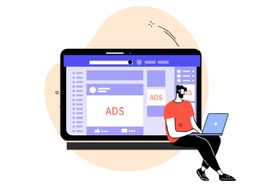Audience Saturation in PPC: Everything You Need to Know in 2025
People are tired of ads, but they don't have to be tired of YOUR ads. Here's how to beat audience saturation in PPC (straight from the experts.)
Published January 31, 2025.

You've heard it before: people are tired of ads. And partially, that might be true. Every day, we are exposed to no less than 4,000 - 10,000 ads -- from the cereal box you open in the morning to the hundreds (maybe more) ads you see on social media within hours of waking up.
Yes, people might be tired of ads -- but as Howard Luck Gossage once said, "Nobody reads ads. People read what interests them, and sometimes that's an ad."
If audience saturation is giving you nightmares, you're in the right place. We've asked the top PPC agencies how they tackle it, and here's what we learned.
The relationship between ad cost and audience saturation
When running digital ad campaigns, understanding the intricate link between ad cost and audience saturation is crucial for long-term success. Audience saturation occurs when your ads are repeatedly shown to the same group of people, limiting their effectiveness over time. This situation can lead to diminishing returns, as your audience either stops engaging with the ads or becomes annoyed by seeing the same content repeatedly. Let's break down the consequences of audience saturation and how it correlates with rising ad costs:
Lower ROI: As your audience becomes saturated, fewer people engage with your ads. This decreased engagement translates into lower returns on your advertising investment, making it harder to justify your ad spend.
Lower conversion rates: Since individuals are repeatedly exposed to your ads, they become less likely to act on your call to action. This causes a decline in conversion rates as the novelty of your message wears off.
Low CTR: A saturated audience is less likely to click on your ads, leading to a reduced click-through rate. This signals to ad platforms that your campaign is no longer relevant or engaging, further impacting performance.
Higher CPC: When audience engagement drops, advertising platforms like Facebook, Google, and LinkedIn adjust your cost-per-click to compensate for the lack of interactions. A higher CPC results in an increase in overall campaign costs.
Insufficient net new reach: Audience saturation means your ads are not reaching new, untapped audiences. Instead, you’re recycling the same pool of users, which limits your brand's growth potential.
Negative feedback: Saturated audiences may feel bombarded by your ads, leading to frustration. This can result in negative feedback such as hiding the ad, reporting it, or even unfollowing your brand, which further damages your campaign performance.
Understanding these effects is the first step to leveraging audience insights and ensuring your ad campaigns remain cost-effective.
Audience saturation vs ad fatigue
Audience saturation and ad fatigue are often used interchangeably, but they are distinct concepts. Both can negatively impact your campaigns, but they arise for different reasons.
Audience saturation occurs when your ads are shown too frequently to the same audience. In other words, there’s a limited pool of people your campaign is targeting, and they’ve already been exposed to your message multiple times. This saturation limits your ability to generate new leads or engagement.
Ad fatigue, on the other hand, happens when your audience becomes tired of seeing the same ad creative. It’s less about the size of your audience and more about the repetitive nature of the content being shown. Even in a large pool of users, if the same ad is displayed repeatedly without variation, the audience will disengage.
Key differences between the two include:
Audience saturation is a targeting issue, while ad fatigue is a creative issue.
Audience saturation can be mitigated by expanding or redefining your targeting parameters, whereas ad fatigue often requires a refresh of ad visuals, copy, or formats.
Both issues can lead to reduced ad performance, but solving them requires different strategies.
Recognizing whether your campaign issue stems from audience saturation or ad fatigue will help you implement targeted solutions for better results.
How to monitor audience saturation
To effectively combat audience saturation, you first need to know how to monitor it. By keeping an eye on key metrics, you can determine when your audience has reached a saturation point and adjust your strategy accordingly. Here are some of the most important indicators to track:
Impression shares: Impression share measures the percentage of times your ad is shown compared to the total opportunities it has to appear. A high impression share within a limited audience can indicate that your campaign is nearing saturation.
Frequency: Frequency is the average number of times an individual user has seen your ad over a specific time period. When frequency is too high, it’s a clear sign your audience is being overexposed to your ads. This can lead to diminishing interest and lower engagement rates.
Cumulative frequency: Cumulative frequency looks at how often a specific group of users has been exposed to your campaign since it began. If this number is consistently high, your audience pool is likely too small, and you’re at risk of saturation.
Other metrics to watch include declining CTR, increasing CPC, and dropping conversion rates. Monitoring these indicators will help you stay proactive and make adjustments before your campaigns become ineffective.
How to beat audience saturation
Once you’ve identified audience saturation in your campaigns, it’s time to roll up your sleeves and implement strategies to overcome it. Here are several actionable ways to address this issue and ensure your campaigns continue to perform:
Redefine your ideal audience
It's time to revisit your buyer personas and audience targeting criteria. Are you focusing too narrowly on a specific demographic or behavior? Expanding your audience can open the door to reaching potential customers you might have overlooked. Broaden your targeting by exploring new demographics, interests, or behaviors that align with your brand.
For example, if you're targeting young professionals, consider including older professionals with similar interests or needs. A fresh perspective on your audience can reinvigorate your campaigns and lead to unexpected results.
Expand to new audiences
If your current audience feels over-targeted or unresponsive, it may be time to branch out. Explore new audience groups to engage with, such as creating lookalike audiences, retargeting users who visited your website but didn’t convert, or targeting entirely new geographic regions.
For instance, if your primary focus has been on urban areas, try reaching rural or suburban markets. By shifting your targeting strategy, you can breathe new life into your campaigns and discover untapped customer potential.
Lower your budget
When ad saturation occurs, showing your ads too frequently can lead to audience fatigue. Reducing your budget can help lower the frequency of your ads, giving your audience a chance to reset. This strategy ensures your message doesn’t become white noise and gives you time to refine your creative or targeting. Once your audience is refreshed, they’ll be more likely to engage positively with your ads when you reintroduce them.
Make sure your goals are specific
Unclear goals can dilute the effectiveness of any campaign. Without a defined objective, your ads may fail to connect with the right audience. Focus on specific, measurable goals, such as increasing free trial sign-ups, promoting a limited-time product offer, or driving app downloads. The more precise your objectives, the easier it is to tailor your messaging and creative to resonate with the intended audience. Clear goals also allow you to measure success more effectively.
Opt for reach campaigns for lower costs
Reach campaigns are designed to get your ads in front of as many people as possible within your targeting parameters. This approach can help expand your audience while keeping costs manageable. If you’re struggling with limited reach, a reach campaign can expose your brand to new users and generate awareness without breaking the bank. It’s a cost-effective strategy for scaling your audience and increasing visibility.
Implement post engagement campaigns
Engagement campaigns encourage interactions like likes, shares, or comments, which can reinvigorate your audience's interest in your brand. Unlike direct sales ads, these campaigns are less intrusive and focus on building rapport with your audience.
For instance, running a campaign that asks a fun question or encourages user-generated content can foster a sense of community. Over time, these interactions build long-term brand loyalty and keep your audience engaged.
Always go for specificity
Specificity is the cornerstone of successful ad campaigns. Whether you’re refining your creative, targeting, or campaign objectives, a tailored approach ensures your ads resonate with a well-defined audience. Instead of creating a generic ad that appeals to everyone, focus on crafting content that speaks directly to your target audience’s needs, desires, or pain points. Specificity enhances relevance, which leads to higher engagement and more meaningful results.
Final thoughts
Audience saturation is a common challenge in digital advertising, but with the right strategies, it’s entirely manageable. By understanding the relationship between ad costs and saturation, monitoring key metrics, and implementing targeted solutions, you can ensure your campaigns maintain their impact. Whether you’re redefining your audience, experimenting with new campaign types, or fine-tuning your creative, staying proactive is the key to long-term advertising success.
Looking for someone to help you run successful, unignorable PPC ads? We've vetted the best PPC agencies in the world, and we're ready to match you with the right one for you in a matter of days. Contact us today and let's talk about your business.






